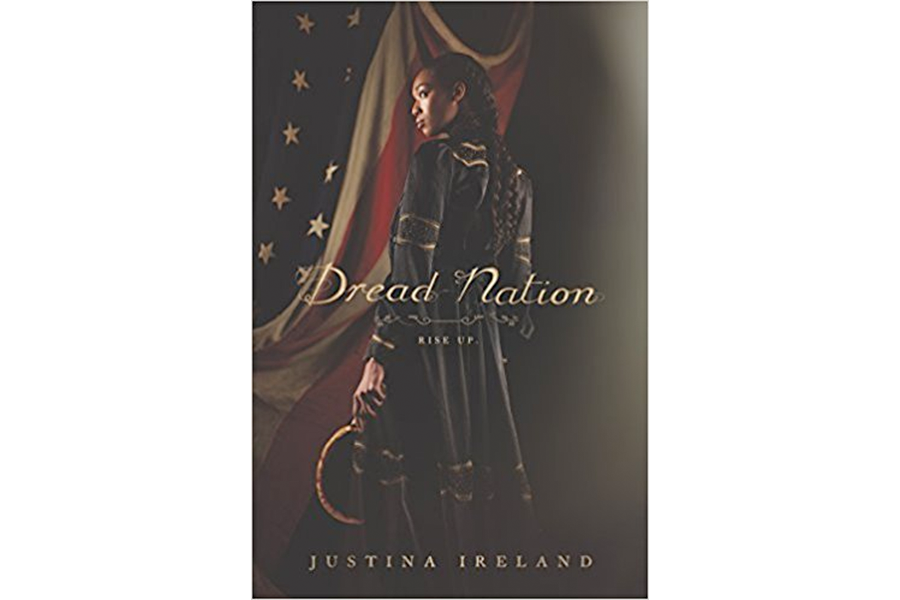'Dread Nation' is a rollicking 'Gone With the Wind + Zombies' adventure
Loading...
Two days after Jane McKeene was born – a black baby to a wealthy white woman in Civil War-era Kentucky – the dead began to rise from the bloody fields of Gettysburg. Now a teenager, Jane attends a combat academy where the curriculum is equal parts etiquette and execution.
I don’t know about you, but I’m all ears.
Dread Nation, Justina Ireland’s latest YA novel, is a rollicking “Gone With the Wind and Zombies” adventure with a biting commentary on contemporary race relations in America. Those overtones should come as little surprise; Ireland is an outspoken activist whose frank comments about diversity in YA have spurred both uproar and introspection. She was recently described in a Vulture profile as “YA Twitter’s leading warrior” and “the most controversial figure in young-adult literature.”
In the warped alt-history of “Dread Nation,” the North and the South have agreed to table the Civil War and battle the undead, known as “shamblers.” Though the original conflict was shelved in the face of the plague, its issues were never resolved. It should be said that modern politics are never out of frame in this novel; Ireland isn’t shy about invoking #MAGA or underlining her point that, as with the shambler hordes, racism just won’t die.
“Dread Nation” politics are dominated by the Survivalist party. She explains, “Survivalists believe that the continued existence of humanity depends on securing the safety of white Christian men and women – whites being superior and closest to God – so that they might ‘set about rebuilding the country in the image of its former glory,’ the way it was before the War Against the Dead.”
The Survivalists see the plague as God’s punishment for previous efforts to establish egalitarianism; scientists have only just began to study viruses and pathogens here. In order to keep shamblers at bay, an earlier Congress passed the Negro and Native Reeducation Act (NNRA), which decreed that blacks and Native Americans alone should fight the undead.
Under the NNRA, minority children are removed from their families and placed in institutions “for the betterment of themselves and of society.” Jane attends one such combat school outside of Baltimore. In an afterword, Ireland unpacks the all-too-real exploitation and forced assimilation in institutions such as the Carlisle Indian Industrial School; she also includes a list of recommended reading material.
If Jane finishes at the top of her class, she could be hired as an Attendant (a kind of battle-ready lady’s maid and virtue chaperone for well-to-do white women). Yet Jane doesn’t care about becoming an Attendant. Her only goal is to return home to her mother’s plantation. She hasn’t received a letter from her mother in almost a year.
As a child, Jane watched friends be infected and subsequently killed. This scarring experience gave her two life lessons: “One: the dead will take everything you love. You have to end them before they can end you. That’s exactly what I aim to do. And two: the person poking the dead ain’t always the one paying for it. In fact, most times, it’s the ones minding their own business who suffer. That’s a problem I still don’t have an answer for yet.”
Jane is a YA treasure. She has voice for days and sass in equal measure, plus a casual relationship with honesty, which gets her both into and out of trouble (“The truth and I ain’t very close – uneasy acquaintances at best.”)
As an experienced fighter and decent markswoman, she takes neither verbal nor physical prisoners. Combat scenes show her dispatching the dead with the same delightful, ruthless efficiency of River Tam from the TV show “Firefly.”
Dialogue in “Dread Nation,” both mental and spoken, has the precision of a dagger and the wallop of a 12-gauge shotgun. Saucy, snappish highlights include Jane’s commentary on her arch rival, Katherine, an “offensively pretty” fellow student whose light skin, blonde hair, and blue eyes “make [Jane] question the school’s admissions criteria.” Katherine is dead-set (no pun intended) on a comfortable Attendant life. She’s forever trying to pass as a lady, even wearing corsets into battle; Jane’s accompanying eyerolls test the limits of ocular physics.
“She’s the prettiest girl at Miss Preston’s, and I figure that’s as good a reason as any to hate her,” Jane quips. “She’s a know-it-all that could try the patience of Jesus Christ himself. I ain’t a very good Christian, so you know where that leaves me.”
When a local family vanishes, Jane finds herself investigating, along with Katherine and a roguish acquaintance. Together, they discover a slew of powerful enemies involved in a massive conspiracy.
Whew! It sounds like a lot of plot, but it flows smoothly under Ireland’s guiding hand. I enjoyed “Dread Nation” far more than I thought I would, as zombie fiction isn’t my typical fare.
Dozens of fandoms will relish “Dread Nation,” though. Send out the word to those who’ve watched “Westworld,” “Firefly,” or “Zombieland”; anyone who’s played the “Borderlands” video games; fans of Gail Carriger’s “Finishing School” or “Parasol Protectorate” series; and readers who crave a splash of wry, cutting humor in this cracked American history.






